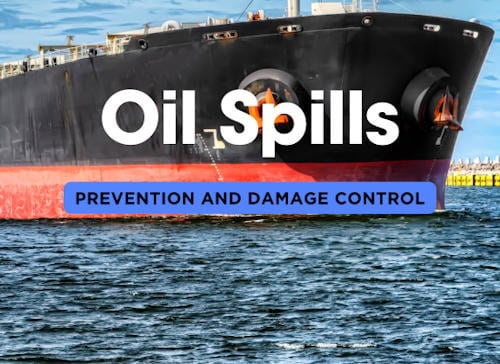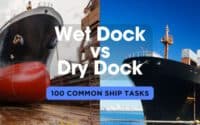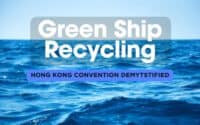Oil Spills: Prevention & Damage Control

Oil spills are one of the most severe environmental threats associated with maritime operations, posing devastating consequences for marine ecosystems and significant financial liabilities for ship owners. As the shipping industry continues to grow, the need for proactive measures to prevent these incidents has never been more critical. This guide delves into the most effective preventative strategies that ship owners and operators can implement to minimize the risk of oil spills. By focusing on routine maintenance, crew training, advanced technologies, and design improvements, we can work together to protect our oceans and ensure the sustainability of maritime commerce.
| ShipUniverse: Preventative Measures for Minimizing Oil Spills | |||
|---|---|---|---|
| Preventative Measure | Description | Implementation Tips | Challenges and Considerations |
| Routine Maintenance and Inspections | Comprehensive maintenance schedules include daily checks, scheduled inspections, and overhauls of critical components like fuel lines, oil tanks, and valves. | Use condition monitoring tools such as ultrasonic thickness gauging and vibration analysis to detect early signs of wear or corrosion. Maintain detailed logs of all inspections and repairs. | Requires significant time and resources. Coordination is needed to avoid disruptions to ship operations. Potential for overlooking minor issues that could escalate. |
| Crew Training and Awareness | Regular and comprehensive training programs ensure that the crew is well-prepared to handle hazardous materials and respond to potential spill scenarios. | Incorporate real-life scenarios in drills. Regularly update training materials to include the latest techniques and technologies. Encourage a culture of safety and proactive reporting. | Continuous training can be costly and time-consuming. Requires commitment from all crew members and management to be effective. |
| Advanced Monitoring Systems | Implementation of real-time monitoring systems that can detect leaks, pressure changes, and breaches in containment systems. | Integrate sensors with the ship's management software for instant alerts. Utilize predictive maintenance tools to analyze sensor data and forecast potential failures. | High initial investment in technology and integration. Requires trained personnel to interpret data and perform necessary maintenance. Potential for false alarms. |
| Proper Ballast Water Management | Adherence to ballast water management practices to prevent contamination and accidental oil discharges during de-ballasting operations. | Regularly inspect and clean ballast tanks. Use ballast water treatment systems to remove oil residues. Plan ballast operations to avoid sensitive areas. | Compliance with international standards can be complex. Costs associated with ballast water treatment systems. Risk of oil contamination during tank cleaning. |
| Tank Level Monitoring | Accurate monitoring of tank levels to prevent overfilling and the subsequent risk of overflow and spills. | Use automated level sensors and alarms. Conduct regular calibrations of sensors to ensure accuracy. Train crew on manual level checks as a backup. | Sensor malfunctions can lead to inaccurate readings. Regular calibration is required. Human error in manual checks. |
| Improved Piping and Valve Maintenance | Regular inspection and maintenance of all piping and valves to ensure they are in good condition and free from leaks. | Implement a strict inspection schedule. Use high-quality materials for repairs. Replace old or worn-out pipes and valves promptly. | Cost of replacement parts and materials. Requires skilled personnel for accurate assessments. Potential for missed early signs of wear. |
| Spill Containment Equipment | Ensuring that spill containment equipment, such as booms and absorbents, is readily available and in good condition. | Regularly inspect and maintain spill containment equipment. Conduct drills to ensure the crew is familiar with deployment procedures. | Equipment can degrade over time if not properly maintained. Space limitations on board for storage. Costs associated with regular replacement of equipment. |
| Enhanced Communication Protocols | Establish clear communication protocols to ensure quick and effective response in case of a spill. | Implement standardized communication procedures. Use dedicated communication channels for emergencies. Regularly review and update protocols. | Miscommunication during an emergency can exacerbate the situation. Ensuring that all crew members are familiar with protocols requires regular training. |
| Preventive Maintenance Software | Utilize software solutions to manage and schedule preventive maintenance tasks efficiently. | Choose software that integrates with existing ship management systems. Ensure all data is kept up-to-date and accessible to relevant personnel. | Initial cost of software and training. Dependence on accurate data input. Potential technical issues or software failures. |
Minimize Damage
In the unfortunate event of an oil spill, the speed and effectiveness of the response are crucial to minimizing environmental damage and financial liability. Having well-established protocols and the right equipment onboard can significantly reduce the impact of a spill. This section focuses on the essential steps that ship crews should take immediately after a spill is detected, including the deployment of containment strategies, the use of emergency spill kits, and the application of dispersants and bioremediation techniques. By implementing these measures swiftly and effectively, ship operators can mitigate the potentially devastating consequences of an oil spill.
| ShipUniverse: Minimizing Damage During a Spill | |||
|---|---|---|---|
| Response Strategy | Description | Implementation Tips | Challenges and Considerations |
| Immediate Response Protocols | Well-defined protocols that outline the steps to take immediately after a spill is detected, including deploying containment booms, shutting off the source of the spill, and notifying authorities. | Conduct regular drills to ensure the crew is familiar with the response protocols. Keep an updated contact list of authorities and spill response teams. Ensure all emergency equipment is easily accessible and in good condition. | Time-sensitive and requires swift action to prevent the spill from spreading. Communication breakdowns can lead to delays. Weather conditions may hinder containment efforts. |
| Emergency Spill Kits | A well-stocked emergency spill kit should include absorbent materials, containment booms, personal protective equipment (PPE), and disposal bags. The kit should be easily accessible and ready for immediate use. | Store spill kits in strategic locations around the ship. Regularly check the contents to ensure they are complete and in good condition. Provide training on how to use each item effectively. | Limited storage space onboard may restrict the size and content of the spill kit. Regular checks and maintenance are required to ensure the kit remains effective. Training is necessary to ensure proper use during an emergency. |
| Use of Dispersants and Bioremediation | Chemical dispersants can break down the oil into smaller particles, while bioremediation agents can help degrade the oil naturally. These methods can reduce the environmental impact of a spill. | Evaluate the spill's location and environmental sensitivity before applying dispersants. Ensure the crew is trained on the proper application methods. Bioremediation should be used in conjunction with other cleanup methods for maximum effectiveness. | Dispersants may not be effective in all conditions and can have environmental trade-offs. Bioremediation requires time to be effective and may not be suitable for immediate response needs. Both methods need careful consideration of environmental impact. |
| Onboard Containment Strategies | Containment strategies involve isolating the spill onboard to prevent it from spreading to other areas of the ship or into the ocean. This can include shutting off affected areas and using containment barriers. | Develop a clear containment plan as part of the ship’s emergency response procedures. Use bulkheads and compartmentalization to isolate the spill. Train the crew on how to quickly deploy containment barriers. | Containment can be challenging in rough seas or during a large spill. Requires quick decision-making and coordination among the crew. Potential for damage to containment barriers during deployment. |
Regulatory Requirements
Navigating the complex landscape of legal and regulatory requirements is crucial for shipowners and operators to minimize the risks associated with oil spills. Compliance with international regulations not only helps prevent incidents but also mitigates the financial and legal consequences in the event of a spill. This section provides an in-depth look at key regulations like MARPOL, as well as the environmental liabilities and insurance options that can safeguard against the significant costs associated with oil spills. Understanding these frameworks is essential for maintaining operational integrity and protecting both the environment and financial assets.
| ShipUniverse: Legal and Regulatory Compliance | |||
|---|---|---|---|
| Compliance Area | Description | Implementation Tips | Challenges and Considerations |
| Understanding MARPOL and Other Regulations | MARPOL (International Convention for the Prevention of Pollution from Ships) sets the global standard for preventing marine pollution, including oil spills. Compliance with MARPOL and other regional regulations is mandatory for all ships. | Ensure all crew members are trained in MARPOL regulations. Regularly review updates to MARPOL and other relevant regulations. Maintain accurate records of all pollution prevention measures and ensure they are easily accessible during inspections. | Compliance can be complex and varies by region. Failing to comply can result in severe penalties, including fines and detentions. Keeping up-to-date with changes in regulations requires ongoing attention. |
| Environmental Liability and Insurance | Oil spills can result in significant environmental damage, leading to substantial financial liabilities. Fines, cleanup costs, and compensation claims can be mitigated by having adequate insurance coverage. | Work with specialized maritime insurers to secure comprehensive coverage. Regularly review and update insurance policies to ensure they cover the latest environmental regulations and potential liabilities. Engage legal experts to understand the full scope of liabilities. | Insurance premiums can be high, particularly for ships operating in sensitive or high-risk areas. Understanding the extent of coverage is critical to avoid gaps that could result in uncovered liabilities. |
| Engagement with Regulatory Bodies | Maintaining open communication with regulatory bodies like the International Maritime Organization (IMO) and regional authorities ensures that your operations remain compliant with current laws and regulations. | Establish direct lines of communication with relevant authorities. Participate in industry forums and regulatory updates provided by organizations like the International Chamber of Shipping (ICS). Regularly audit compliance practices to align with regulatory expectations. | Regulatory landscapes can shift rapidly, requiring constant monitoring. Miscommunication or delays in reporting can lead to non-compliance. Engaging with multiple regulatory bodies across regions can be resource-intensive. |
| Documentation and Reporting | Accurate documentation and timely reporting are critical components of legal compliance. This includes maintaining records of all preventive measures, spill incidents, and corrective actions. | Implement a robust documentation system that is accessible to all relevant personnel. Regularly update records and ensure that they are submitted to regulatory bodies as required. Use digital platforms for easier management and retrieval of documentation. | Failure to maintain accurate records can lead to penalties and increased scrutiny. The administrative burden of keeping detailed records can be significant, especially for large fleets. Digital systems require secure and reliable IT infrastructure. |
Future Trends
Oil spill prevention and response efforts are only as effective as the systems and strategies in place to ensure that spills are avoided altogether. These measures not only protect the environment but also help avoid significant financial losses. This section focuses on long-term strategies for preventing oil spills, including the development of spill prevention plans, the use of advanced technologies, and the continuous improvement of operational practices. By investing in these areas, shipowners can create a safer and more sustainable future for their fleets.
| ShipUniverse: Long-Term Strategies for Oil Spill Prevention | |||
|---|---|---|---|
| Strategy | Description | Implementation Tips | Challenges and Considerations |
| Development of Spill Prevention Plans | Comprehensive spill prevention plans outline the steps to avoid spills and ensure that all crew members are aware of their roles and responsibilities. | Involve key stakeholders in the development of the plan, including crew members, environmental experts, and legal advisors. Regularly review and update the plan to reflect changes in regulations and best practices. | Keeping the plan up-to-date requires continuous monitoring of regulations and industry standards. Involvement from all levels of the organization is necessary for successful implementation. |
| Use of Advanced Technologies | Leveraging advanced technologies, such as AI-powered monitoring systems and automated leak detection, can significantly reduce the risk of oil spills. | Invest in the latest technologies that provide real-time data on ship operations. Ensure that all systems are regularly tested and maintained to avoid failures. Train crew members to understand and operate these technologies effectively. | High initial investment costs. Continuous maintenance and updates are required. Potential resistance to adopting new technologies from crew members or management. |
| Continuous Improvement of Operational Practices | Regularly reviewing and improving operational practices ensures that spill prevention measures remain effective and up-to-date. | Establish a culture of continuous improvement within the organization. Conduct regular audits and assessments to identify areas for improvement. Involve the crew in identifying practical enhancements to daily operations. | Requires ongoing commitment from all levels of the organization. Implementing changes can be disruptive to operations. Balancing improvement efforts with day-to-day responsibilities can be challenging. |
| Collaboration with Environmental Organizations | Partnering with environmental organizations like the World Wildlife Fund (WWF) can help enhance spill prevention strategies and ensure that operations are aligned with environmental conservation goals. | Engage with reputable environmental organizations to gain insights into best practices and emerging trends. Participate in joint initiatives to promote environmental stewardship. Incorporate feedback from these organizations into spill prevention plans. | Finding the right partners who align with your company’s values. Potential costs associated with partnerships and joint initiatives. Balancing environmental goals with operational efficiency. |
| Investment in Crew Training and Development | Continuous investment in crew training and development ensures that all personnel are equipped with the knowledge and skills needed to prevent spills. | Implement regular training programs that cover both basic and advanced spill prevention techniques. Encourage continuous learning and professional development among crew members. Evaluate training effectiveness through drills and assessments. | Training requires time and resources. Keeping training programs up-to-date with the latest regulations and technologies can be challenging. Ensuring that all crew members are equally engaged in the training process. |
Additional References
International Maritime Organization (IMO)
- URL: https://www.imo.org/
- Description: The IMO is a specialized agency of the United Nations responsible for regulating shipping. It sets global standards for the safety, security, and environmental performance of international shipping, including regulations like MARPOL, which governs oil spill prevention.
United States Environmental Protection Agency (EPA)
- URL: https://www.epa.gov/oil-spills-prevention-and-preparedness-regulations
- Description: The EPA provides guidelines and regulations for oil spill prevention, preparedness, and response in the United States. The site offers resources and regulatory information to help prevent oil spills in navigable waters.
European Maritime Safety Agency (EMSA)
- URL: http://www.emsa.europa.eu/
- Description: EMSA is responsible for ensuring maritime safety and environmental protection within the European Union. The agency offers technical assistance and operational support for oil spill response and prevention.
National Oceanic and Atmospheric Administration (NOAA)
- URL: https://response.restoration.noaa.gov/
- Description: NOAA provides scientific support for oil spill response and restoration efforts in U.S. waters. The site offers resources on oil spill response, including tools, data, and guidelines.
International Tanker Owners Pollution Federation (ITOPF)
- URL: https://www.itopf.org/
- Description: ITOPF is a not-for-profit organization that provides technical advice on effective oil spill response and the mitigation of marine spills. It is one of the world’s leading authorities on pollution from ships.
World Wildlife Fund (WWF)
- URL: https://www.wwf.org/
- Description: WWF is an international non-governmental organization working in the field of wilderness preservation and the reduction of human impact on the environment. They are involved in various initiatives related to marine conservation and oil spill prevention.
Australian Maritime Safety Authority (AMSA)
- URL: https://www.amsa.gov.au/
- Description: AMSA is responsible for maritime safety, protection of the marine environment, and maritime emergency response in Australian waters. The site includes information on oil spill response and prevention.
Canada’s Marine Oil Spill Preparedness and Response Regime
- URL: https://www.tc.gc.ca/en/services/marine/marine-environmental-protection/marine-oil-spill-preparedness-response-regime.html
- Description: Transport Canada’s site on marine oil spill preparedness and response, which includes information on Canada's regulations and frameworks for preventing and responding to oil spills.
International Oil Pollution Compensation Funds (IOPC Funds)
- URL: https://iopcfunds.org/
- Description: The IOPC Funds provide financial compensation for oil pollution damage resulting from spills of persistent oil from tankers. The site offers information on the compensation regime and claims process.
Global Initiative for West, Central, and Southern Africa (GI WACAF)
- URL: http://www.giwacaf.net/
- Description: GI WACAF is a project between the IMO and IPIECA (the global oil and gas industry association for environmental and social issues). It aims to enhance the capacity of countries in West, Central, and Southern Africa to prepare for and respond to marine oil spills.

Do you have a Maritime Product or Service that may be of interest to Shipowners? Tell us about it here!
Do you have feedback or insights? Please reach out to editor @ shipuniverse.com



